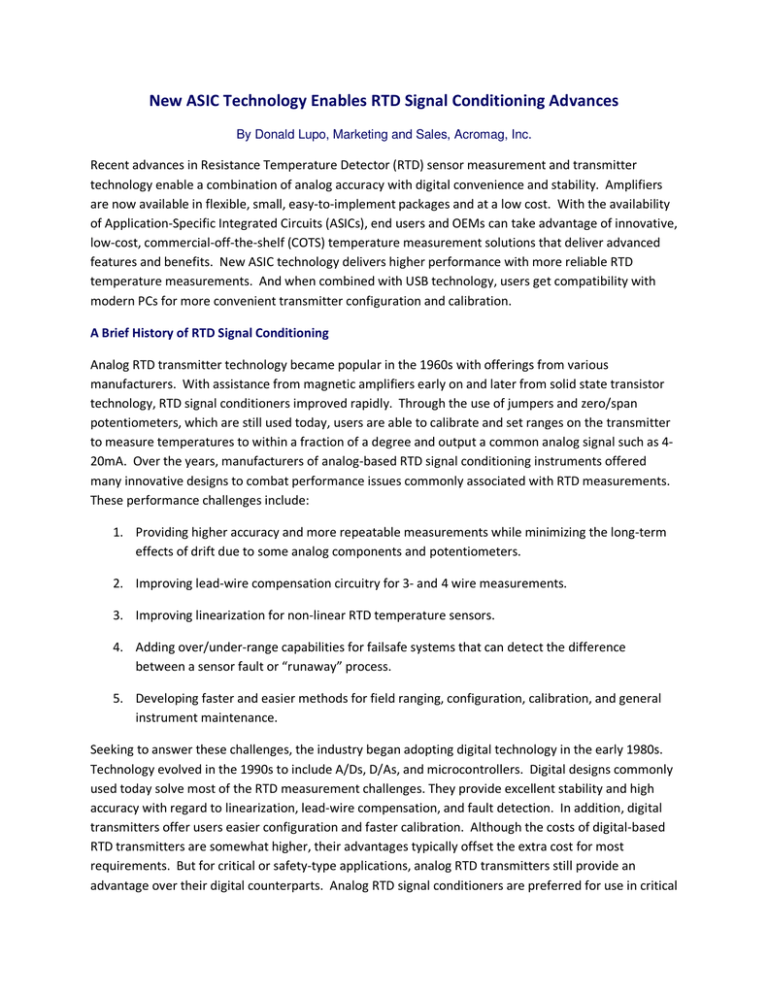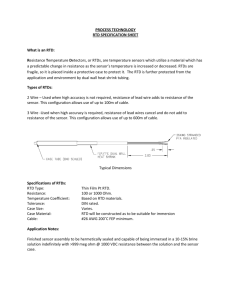New RTD Signal Conditioning Technology
advertisement

New ASIC Technology Enables RTD Signal Conditioning Advances By Donald Lupo, Marketing and Sales, Acromag, Inc. Recent advances in Resistance Temperature Detector (RTD) sensor measurement and transmitter technology enable a combination of analog accuracy with digital convenience and stability. Amplifiers are now available in flexible, small, easy-to-implement packages and at a low cost. With the availability of Application-Specific Integrated Circuits (ASICs), end users and OEMs can take advantage of innovative, low-cost, commercial-off-the-shelf (COTS) temperature measurement solutions that deliver advanced features and benefits. New ASIC technology delivers higher performance with more reliable RTD temperature measurements. And when combined with USB technology, users get compatibility with modern PCs for more convenient transmitter configuration and calibration. A Brief History of RTD Signal Conditioning Analog RTD transmitter technology became popular in the 1960s with offerings from various manufacturers. With assistance from magnetic amplifiers early on and later from solid state transistor technology, RTD signal conditioners improved rapidly. Through the use of jumpers and zero/span potentiometers, which are still used today, users are able to calibrate and set ranges on the transmitter to measure temperatures to within a fraction of a degree and output a common analog signal such as 420mA. Over the years, manufacturers of analog-based RTD signal conditioning instruments offered many innovative designs to combat performance issues commonly associated with RTD measurements. These performance challenges include: 1. Providing higher accuracy and more repeatable measurements while minimizing the long-term effects of drift due to some analog components and potentiometers. 2. Improving lead-wire compensation circuitry for 3- and 4 wire measurements. 3. Improving linearization for non-linear RTD temperature sensors. 4. Adding over/under-range capabilities for failsafe systems that can detect the difference between a sensor fault or “runaway” process. 5. Developing faster and easier methods for field ranging, configuration, calibration, and general instrument maintenance. Seeking to answer these challenges, the industry began adopting digital technology in the early 1980s. Technology evolved in the 1990s to include A/Ds, D/As, and microcontrollers. Digital designs commonly used today solve most of the RTD measurement challenges. They provide excellent stability and high accuracy with regard to linearization, lead-wire compensation, and fault detection. In addition, digital transmitters offer users easier configuration and faster calibration. Although the costs of digital-based RTD transmitters are somewhat higher, their advantages typically offset the extra cost for most requirements. But for critical or safety-type applications, analog RTD transmitters still provide an advantage over their digital counterparts. Analog RTD signal conditioners are preferred for use in critical systems because they offer better reliability. For example, it is believed they are more immune to severe electrical surges or electromagnetic impulses that may cause a digital “upset” within a system. Along Comes ASIC New, innovative ASIC technology for RTD signal conditioners now offers the performance advantages of digital technology with the reliability advantage of analog technology. Additionally, ASIC technology is available at a much a lower cost and with a smaller footprint. Today’s ASICs allow users to digitally control and calibrate an analog amplifier. They increase performance and reliability by consolidating several functions into a single integrated circuit and use digital control of calibration, linearization, and sensor fault parameters. No potentiometers, jumpers, dip-switches or pushbuttons are needed for adjustment. RTD ASICs do not run an instruction set like a microprocessor, nor do they use an A/D on the front end. Essentially, they use an analog programmable gain amplifier (PGA) internally which is digitally controlled. For example, digitally controlled D/A converters precisely set the zero offset, sensor excitation and linearization for the analog signal path. This scheme delivers the equivalent of 12-bit performance without digitizing the signal. It’s simply an analog transmitter with digital control and calibration. When this RTD ASIC is combined with non-volatile memory and a USB interface, users gain many advantages and flexibility. As shown in the block diagram, EEPROM is pre-loaded with information via a USB connection to a PC that runs easy-to-use configuration software. The RTD ASIC uploads this content at power-up to define its operation. It supports precision 2-wire, 3-wire, or 4-wire RTD measurement and offers a standard 4-20mA loop powered output. ASICs offer all the features you would expect from a digital microprocessor-based RTD transmitter and more: excellent accuracy (<0.1%), increased stability (<100ppm/C), programmable 2, 3, or 4-wire measurements, improved lead-wire compensation, dynamic sensor linearization, programmable over/under range values, and selectable sensor fault detection. Acromag’s new ASIC-based RTD transmitter is a miniature, DIN Form B, field-mount instrument. Users benefit from the flexibility and stability of a digitally controlled device with the accuracy and reliability of a fully analog signal path. This technology, combined with a USB interface, offers easy configuration and fast calibration using a modern PC. For more information on these technology advancements and their implementation, go to www.acromag.com and search for the Model ST131. Acromag Wixom, MI. (248) (248) 295-0880. [http://www.acromag.com].


